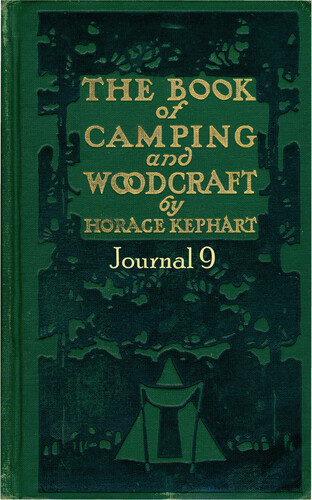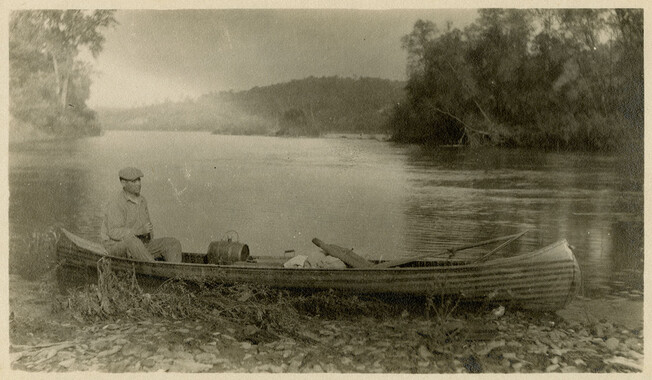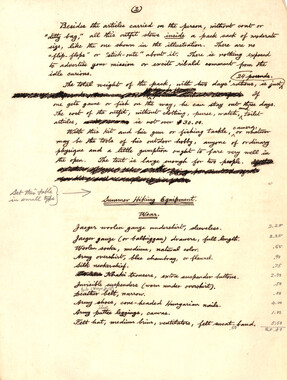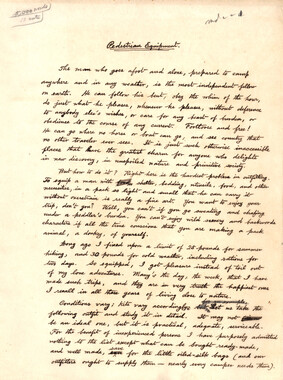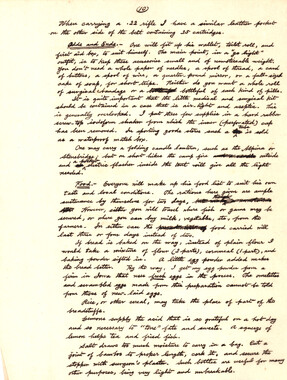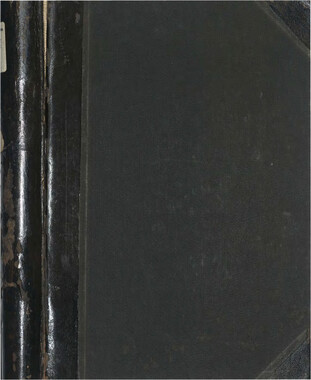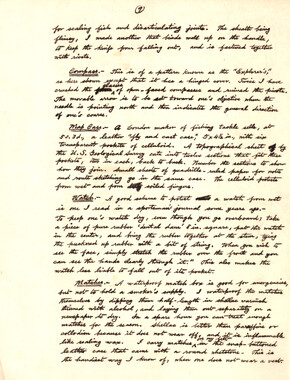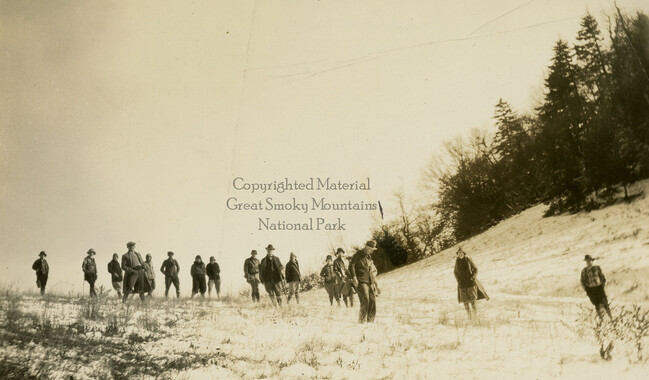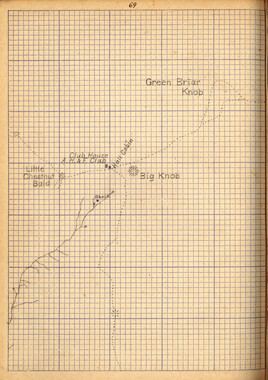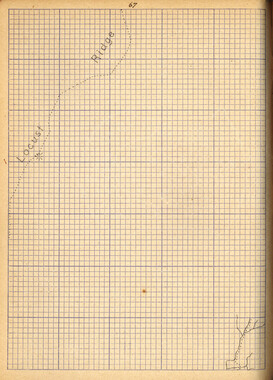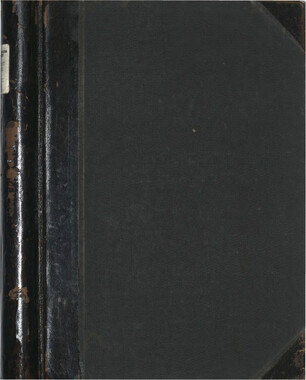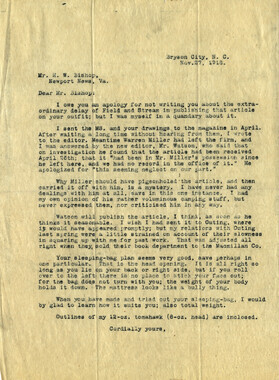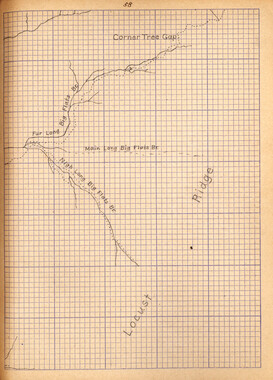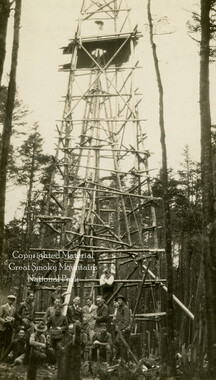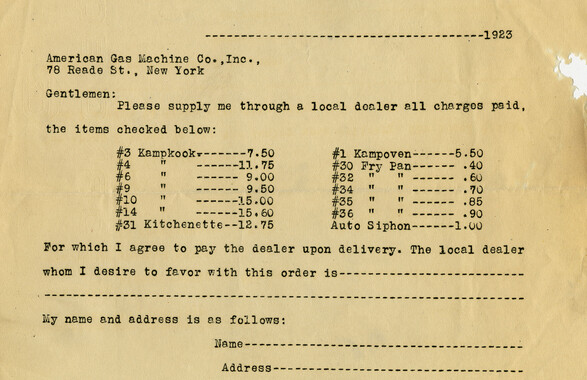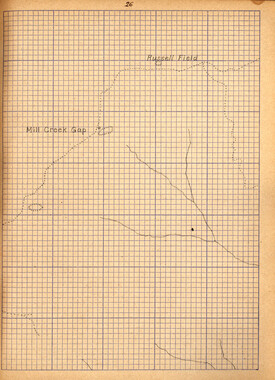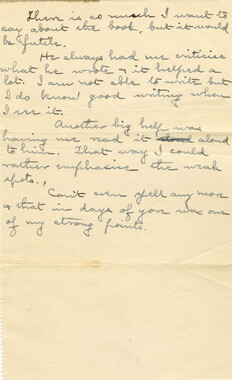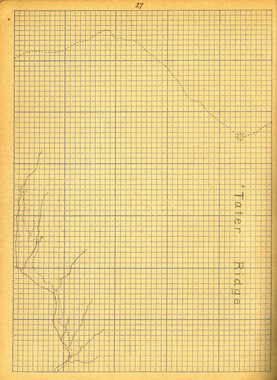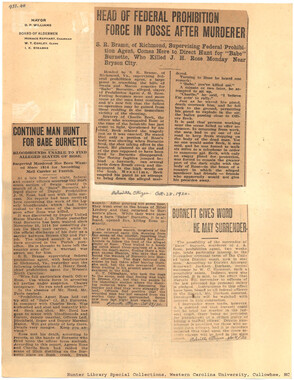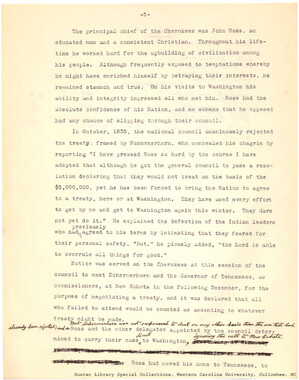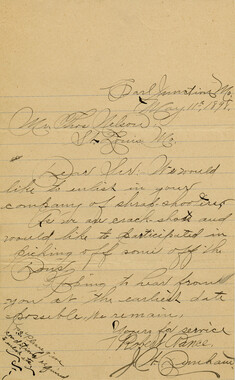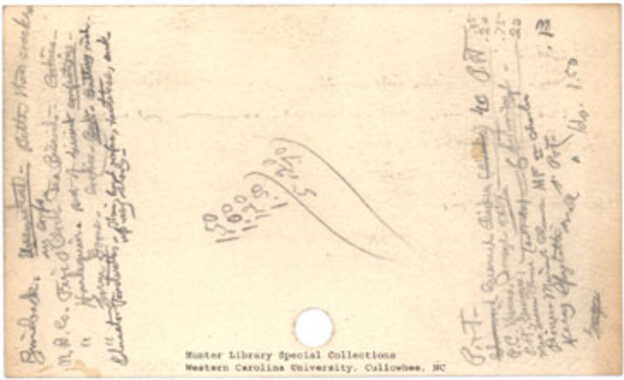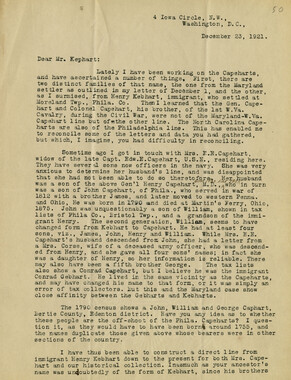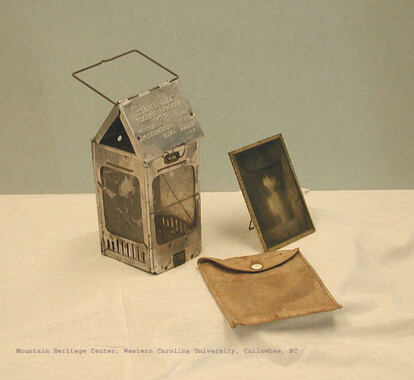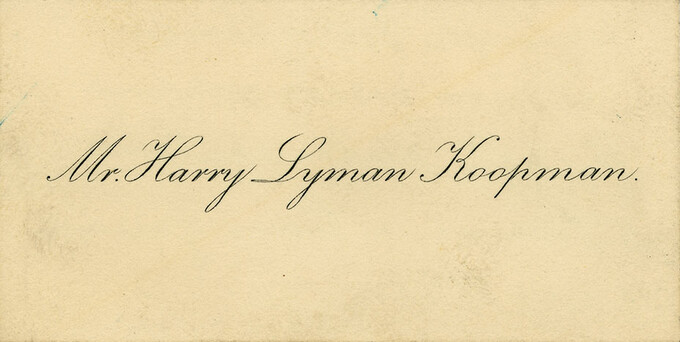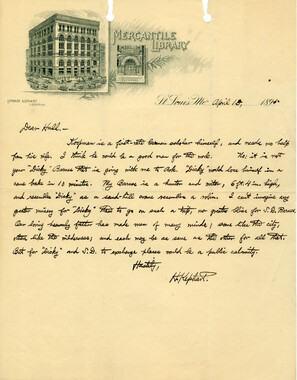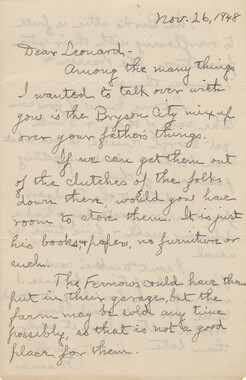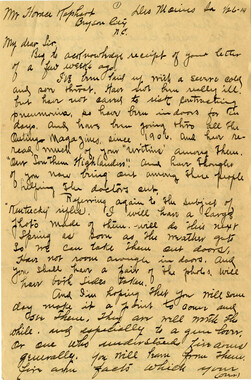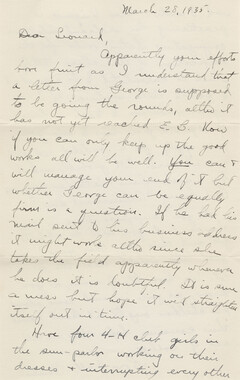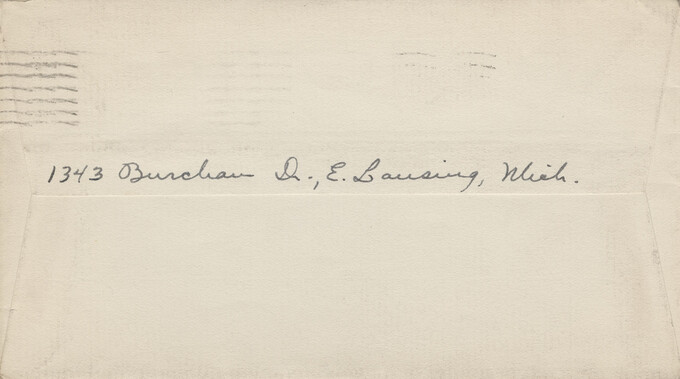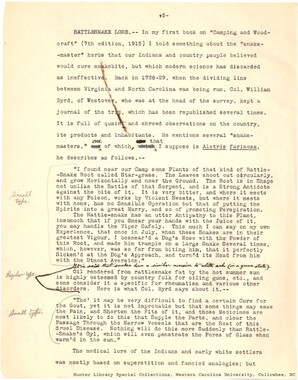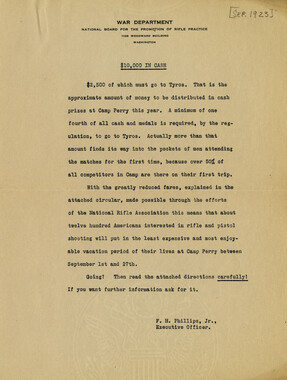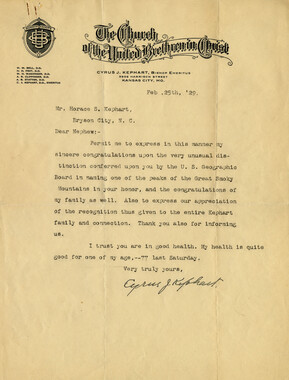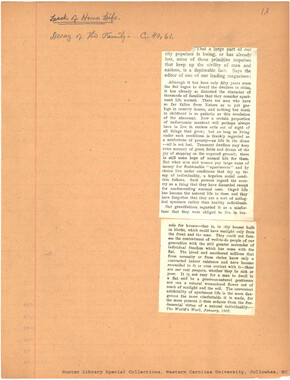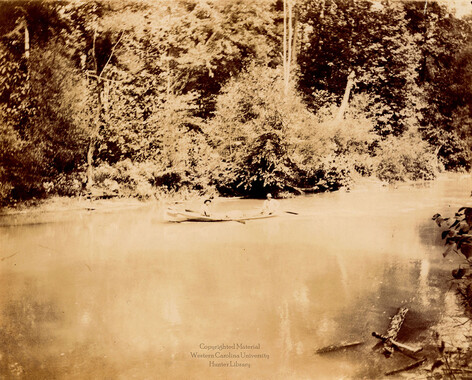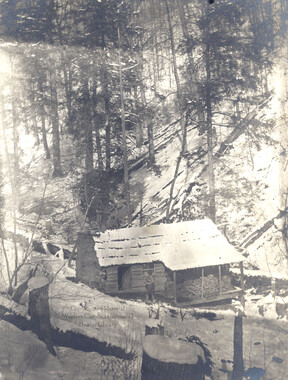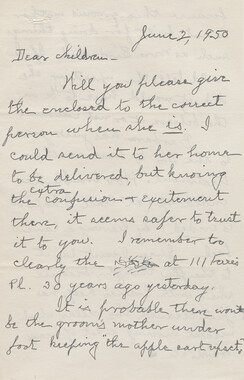Western Carolina University (20)
View all
- Canton Champion Fibre Company (2308)
- Cherokee Traditions (292)
- Civil War in Southern Appalachia (165)
- Craft Revival (1942)
- Great Smoky Mountains - A Park for America (2766)
- Highlights from Western Carolina University (430)
- Horace Kephart (941)
- Journeys Through Jackson (154)
- LGBTQIA+ Archive of Jackson County (85)
- Oral Histories of Western North Carolina (314)
- Picturing Appalachia (6772)
- Stories of Mountain Folk (413)
- Travel Western North Carolina (160)
- Western Carolina University Fine Art Museum Vitreograph Collection (129)
- Western Carolina University Herbarium (92)
- Western Carolina University: Making Memories (708)
- Western Carolina University Publications (2283)
- Western Carolina University Restricted Electronic Theses and Dissertations (146)
- Western North Carolina Regional Maps (71)
- World War II in Southern Appalachia (131)
University of North Carolina Asheville (6)
View all
- Kephart, Calvin, 1883-1969 (15)
- Kephart, Horace, 1862-1931 (290)
- Kephart, Laura, 1862-1954 (39)
- Masa, George, 1881-1933 (1)
- Thompson, James Edward, 1880-1976 (1)
- Weaver, Zebulon, 1872-1948 (3)
- Allanstand Cottage Industries (0)
- Appalachian National Park Association (0)
- Bennett, Kelly, 1890-1974 (0)
- Berry, Walter (0)
- Brasstown Carvers (0)
- Cain, Doreyl Ammons (0)
- Carver, George Washington, 1864?-1943 (0)
- Cathey, Joseph, 1803-1874 (0)
- Champion Fibre Company (0)
- Champion Paper and Fibre Company (0)
- Cherokee Indian Fair Association (0)
- Cherokee Language Program (0)
- Crittenden, Lorraine (0)
- Crowe, Amanda (0)
- Edmonston, Thomas Benton, 1842-1907 (0)
- Ensley, A. L. (Abraham Lincoln), 1865-1948 (0)
- Fromer, Irving Rhodes, 1913-1994 (0)
- George Butz (BFS 1907) (0)
- Goodrich, Frances Louisa (0)
- Grant, George Alexander, 1891-1964 (0)
- Heard, Marian Gladys (0)
- Laney, Gideon Thomas, 1889-1976 (0)
- McElhinney, William Julian, 1896-1953 (0)
- Niggli, Josephina, 1910-1983 (0)
- North Carolina Park Commission (0)
- Osborne, Kezia Stradley (0)
- Owens, Samuel Robert, 1918-1995 (0)
- Penland Weavers and Potters (0)
- Rhodes, Judy (0)
- Roberts, Vivienne (0)
- Roth, Albert, 1890-1974 (0)
- Schenck, Carl Alwin, 1868-1955 (0)
- Sherrill's Photography Studio (0)
- Smith, Edward Clark (0)
- Southern Highland Handicraft Guild (0)
- Southern Highlanders, Inc. (0)
- Stalcup, Jesse Bryson (0)
- Stearns, I. K. (0)
- United States. Indian Arts and Crafts Board (0)
- USFS (0)
- Vance, Zebulon Baird, 1830-1894 (0)
- Western Carolina College (0)
- Western Carolina Teachers College (0)
- Western Carolina University (0)
- Western Carolina University. Mountain Heritage Center (0)
- Whitman, Walt, 1819-1892 (0)
- Wilburn, Hiram Coleman, 1880-1967 (0)
- Williams, Isadora (0)
- 1880s (10)
- 1890s (29)
- 1900s (8)
- 1910s (138)
- 1920s (219)
- 1930s (33)
- 1940s (35)
- 1950s (15)
- 1600s (0)
- 1700s (0)
- 1800s (0)
- 1810s (0)
- 1820s (0)
- 1830s (0)
- 1840s (0)
- 1850s (0)
- 1860s (0)
- 1870s (0)
- 1960s (0)
- 1970s (0)
- 1980s (0)
- 1990s (0)
- 2000s (0)
- 2010s (0)
- 2020s (0)
- Appalachian Region, Southern (69)
- Blount County (Tenn.) (1)
- Buncombe County (N.C.) (5)
- Henderson County (N.C.) (1)
- Jackson County (N.C.) (6)
- Knox County (Tenn.) (2)
- Knoxville (Tenn.) (1)
- Macon County (N.C.) (1)
- Mitchell County (N.C.) (2)
- Qualla Boundary (1)
- Swain County (N.C.) (88)
- Asheville (N.C.) (0)
- Avery County (N.C.) (0)
- Cherokee County (N.C.) (0)
- Clay County (N.C.) (0)
- Graham County (N.C.) (0)
- Great Smoky Mountains National Park (N.C. and Tenn.) (0)
- Haywood County (N.C.) (0)
- Lake Santeetlah (N.C.) (0)
- Madison County (N.C.) (0)
- McDowell County (N.C.) (0)
- Polk County (N.C.) (0)
- Rutherford County (N.C.) (0)
- Transylvania County (N.C.) (0)
- Watauga County (N.C.) (0)
- Waynesville (N.C.) (0)
- Yancey County (N.C.) (0)
- Artifacts (object Genre) (85)
- Clippings (information Artifacts) (15)
- Envelopes (37)
- Glass Plate Negatives (5)
- Letters (correspondence) (366)
- Manuscripts (documents) (273)
- Maps (documents) (3)
- Memorandums (1)
- Photographs (195)
- Portraits (8)
- Postcards (5)
- Publications (documents) (6)
- Aerial Photographs (0)
- Aerial Views (0)
- Albums (books) (0)
- Articles (0)
- Bibliographies (0)
- Biography (general Genre) (0)
- Cards (information Artifacts) (0)
- Crafts (art Genres) (0)
- Depictions (visual Works) (0)
- Design Drawings (0)
- Drawings (visual Works) (0)
- Facsimiles (reproductions) (0)
- Fiction (general Genre) (0)
- Financial Records (0)
- Fliers (printed Matter) (0)
- Guidebooks (0)
- Internegatives (0)
- Interviews (0)
- Land Surveys (0)
- Minutes (administrative Records) (0)
- Negatives (photographs) (0)
- Newsletters (0)
- Newspapers (0)
- Occupation Currency (0)
- Paintings (visual Works) (0)
- Pen And Ink Drawings (0)
- Periodicals (0)
- Personal Narratives (0)
- Plans (maps) (0)
- Poetry (0)
- Programs (documents) (0)
- Questionnaires (0)
- Scrapbooks (0)
- Sheet Music (0)
- Slides (photographs) (0)
- Songs (musical Compositions) (0)
- Sound Recordings (0)
- Specimens (0)
- Speeches (documents) (0)
- Text Messages (0)
- Tintypes (photographs) (0)
- Transcripts (0)
- Video Recordings (physical Artifacts) (0)
- Vitreographs (0)
- Horace Kephart Collection (729)
- A.L. Ensley Collection (0)
- Appalachian Industrial School Records (0)
- Appalachian National Park Association Records (0)
- Axley-Meroney Collection (0)
- Bayard Wootten Photograph Collection (0)
- Bethel Rural Community Organization Collection (0)
- Blumer Collection (0)
- C.W. Slagle Collection (0)
- Canton Area Historical Museum (0)
- Carlos C. Campbell Collection (0)
- Cataloochee History Project (0)
- Cherokee Studies Collection (0)
- Daisy Dame Photograph Album (0)
- Daniel Boone VI Collection (0)
- Doris Ulmann Photograph Collection (0)
- Elizabeth H. Lasley Collection (0)
- Elizabeth Woolworth Szold Fleharty Collection (0)
- Frank Fry Collection (0)
- George Masa Collection (0)
- Gideon Laney Collection (0)
- Hazel Scarborough Collection (0)
- Hiram C. Wilburn Papers (0)
- Historic Photographs Collection (0)
- Humbard Collection (0)
- Hunter and Weaver Families Collection (0)
- I. D. Blumenthal Collection (0)
- Isadora Williams Collection (0)
- Jesse Bryson Stalcup Collection (0)
- Jim Thompson Collection (0)
- John B. Battle Collection (0)
- John C. Campbell Folk School Records (0)
- John Parris Collection (0)
- Judaculla Rock project (0)
- Kelly Bennett Collection (0)
- Love Family Papers (0)
- Major Wiley Parris Civil War Letters (0)
- Map Collection (0)
- McFee-Misemer Civil War Letters (0)
- Mountain Heritage Center Collection (0)
- Norburn - Robertson - Thomson Families Collection (0)
- Pauline Hood Collection (0)
- Pre-Guild Collection (0)
- Qualla Arts and Crafts Mutual Collection (0)
- R.A. Romanes Collection (0)
- Rosser H. Taylor Collection (0)
- Samuel Robert Owens Collection (0)
- Sara Madison Collection (0)
- Sherrill Studio Photo Collection (0)
- Smoky Mountains Hiking Club Collection (0)
- Stories of Mountain Folk - Radio Programs (0)
- The Reporter, Western Carolina University (0)
- Venoy and Elizabeth Reed Collection (0)
- WCU Gender and Sexuality Oral History Project (0)
- WCU Mountain Heritage Center Oral Histories (0)
- WCU Oral History Collection - Mountain People, Mountain Lives (0)
- WCU Students Newspapers Collection (0)
- Western North Carolina Tomorrow Black Oral History Project (0)
- William Williams Stringfield Collection (0)
- Zebulon Weaver Collection (0)
- Appalachian Trail (6)
- Forest conservation (2)
- Forests and forestry (5)
- Great Smoky Mountains National Park (N.C. and Tenn.) (18)
- Hunting (7)
- Maps (2)
- Mines and mineral resources (3)
- Postcards (1)
- World War, 1939-1945 (4)
- African Americans (0)
- Artisans (0)
- Cherokee art (0)
- Cherokee artists -- North Carolina (0)
- Cherokee language (0)
- Cherokee pottery (0)
- Cherokee women (0)
- Church buildings (0)
- Civilian Conservation Corps (U.S.) (0)
- College student newspapers and periodicals (0)
- Dams (0)
- Dance (0)
- Education (0)
- Floods (0)
- Folk music (0)
- Forced removal, 1813-1903 (0)
- Gender nonconformity (0)
- Landscape photography (0)
- Logging (0)
- North Carolina -- Maps (0)
- Paper industry (0)
- Pottery (0)
- Railroad trains (0)
- Rural electrification -- North Carolina, Western (0)
- School integration -- Southern States (0)
- Segregation -- North Carolina, Western (0)
- Slavery (0)
- Sports (0)
- Storytelling (0)
- Waterfalls -- Great Smoky Mountains (N.C. and Tenn.) (0)
- Weaving -- Appalachian Region, Southern (0)
- Wood-carving -- Appalachian Region, Southern (0)
- StillImage (296)
- Text (647)
- MovingImage (0)
- Sound (0)
Horace Kephart Journal 09
-
Horace Kephart (1862-1931) was a noted naturalist, woodsman, journalist, and author. In 1904, he left St. Louis and permanently moved to western North Carolina. Living and working in a cabin on Hazel Creek in Swain County, Kephart began to document life in the Great Smoky Mountains. He created 27 journals in which he made copious notes on a variety of topics. Journals 5 through 11 deal with various aspects of outdoor life and contributed to his popular book, “Camping and Woodcraft.” First published in 1906 under the title “The Book of Camping and Woodcraft: A Guidebook for Those Who Travel in the Wilderness," the 1916/1917 edition of "Camping and Woodcraft" is considered a standard manual for campers after almost a century of use. Journal 9 (previously known as Journal XXII) includes information on canoeing and other types of boating, hiking and marching as well as high altitude hiking, more on tents and packs, fire making, edible wild plants, snaring of animals for food, and basic surveying. Click the link in the Related Materials field to view a table of contents for this journal.
-
-
11. 1. CANOEING. I .:a>;;.,.. Canoe as shelter.-- Breck,74,ill. (See also llb,Canoe Temts). 2lJ-J', {./1. :u Who cares for a portage or two with comfort like this at the end of the long day ? No tent to bother with, either ,z.:..; '- • "i: How I Came to Be a. Canoeist Bv RoBERT J. WILKIN, A. C. A., No. 47 I THINK it was in 1877 that I took up canoeing. I had been engaged for some two years in a business which kept me very closely confined to the office, writing on books and papers and continually bending over a desk, and my family and friends said that they noticed that I was not only getting round-shouldered, but that my chest was not as well developed as it had been, nor did I look so well in health. I felt that I needed some exercise in the open air, and I at once began to study the particular pleasure or sport I should follow to accomplish my purpose. Whatever it should be, one requirement was absolutely necessary-it must be on the water. I could not afford a yacht, and as I had been rowing off and on for a great many years and enjoyed the sport very much, I decided to row a boat. On looking over the professional oarsmen, I found, however, that almost all of them, although deep chested, had their principal body development behind the shoulders rather than in front, and that most of them were round shouldered and low chested, the power of the lungs usually being carried in the back rather than across the chest. I was quite sure then that ,rowing would not -supply what I wanted. It so happened that I dropped in at Brentano's Book Store, then loc"ated on Union Square, and there conferred "with Arthur Brentano, who afterwards became one of the proprietors. He told me that he, too, was seeking some similar sport and for a like reason, and he asked me -if I had read a little pamphlet which had been recently issued by the "funny man of the New York Times," W. L. Alden. As I had not, he ' let me have a copy, which was entitled, "The Canoe and Flying Proa." I 'read this with great interest and went back to Mr. Brentano who at that time said 'that he had a book just published called, "Kanoeing in Kanuckia." This book I purchased, and before I had finished its two hundred pages, I had made up my mind that canoeing was the sport for me. At that time I was a member of the American Walking Club. One day I accompanied the mem hers on a · walk from Jersey City to Fort Lee, and as we passed along the shore at Pleasant Valley, I saw out on the Hudson River the most peculiar looking little boat I had ever seen. I hailed the man and boat ashore, and learned it was Mr. Frank Herwig, the Assistant Chief Engineer of the Hoboken Fire Department, who had a little canvas canoe shaped somewhat after the original McGregor type. He had a little spritsail hardly larger than a handkerchief, and while I did not see him use it, he said it carried him along very nicely with the wind. I made arrangements to meet Mr. Herwig the following week and tried paddling. He certainly had a boat that would not encourage the growth of canoeing, as I have never been in a canoe since that day that seemed so unstable as that little canvas covered Kyak of a canoe, the first I had ever seen. T he following week Mr. Brentano and I discussed my find and I took him over to look at the boat and try it on the river opposite the Elysian fields. At this time there appeared in one of the Jersey City papers an article by Mr. Charles E. Chase, describing the sport of canoeing and telling how a number of young men at Communipaw proposed to organize a club, having been able to find a builder who, for Thirty Dollars, could turn out a canvas covered canoe which could be rigged and sailed. Mr. Brentano and I went to Comm1,1nipaw the next Sunday and there met some of the pioneers of canoeing in this country. The boats that were built by Mr. Lyon were of canvas stretched over an open framework, and while they seemed to work splendidly with us for a period of two or three years, at the sa!Jle time I have ne'ver seen any boats built like them nor after the same general pattern since. We found that they were stable, comfortable, and could be pleasantly paddled. I remember my first "cruise" was from Com· munipaw out around Bedloe's Island and back again, then about three miles. I was lame for three or four days afterward, but I had had the sport, and before the Summer was over we had organized the Jersey City Canoe Club. The New York Canoe Club had been organized some seven or eight years before this time! think in r87r-but we looked upon the members of that club, who had a real boathouse on Staten Island, as such swells as would preclude the possibility of our ever joining such an organization. Our little club progressed for two or three years, .and in r88o, at the first meeting of the American Canoe Association at Lake George, we had three or four representatives, and some of us were fortunate enough to win prizes in the races. I continued with the Jersey City Club until r88o, when Mr. Brentano, Mr. H. T. Keyser and I called a meeting of canoeists in and around New York City at McGregor Hall, on Fifth Avenue near Fifteenth Street, and organized the Knickerbocker Canoe Club, which is still in existence. Every one of us has gone into canoeing for one reason or another. I suppose the reason that took me into the sport, which I have enjoyed for so many years, is somewhat peculiar as we usually do not take up our sports after careful study as to the results we expect to accomplish, but the pulling of the oar by the oarsmen enlarges the muscles of the back to the disadvantage of the chest muscles, while the use either of the Judge Robert J. Wilkin Ruddy cheeks and hardy, though nearer three score than two, Judge Robert J. Wilkin, known as "THE FATHER" of the Childrens' Court in Brooklyn, is an ardent apostle of the outdoor life. A frequent winner of canoe races, and a regular attendant at the annual gathering of the American Canoe Association, Thousand Islands, he takes his outdoor exercise, when he can't get canoeing, in any other way possible. Judge Wilkin is a great walker and his almost invariable Sunday morning habit is to take a stroll of fifteen or twenty miles from his home to the country house of the Crescent Athletic Club by the way of Bath Beach or Coney Island. He doesn't disdain yachting, but takes frequent trips on the yawl, AEOLUS, with his friend, Embury McLean. The Judge owns an Island in the St. Lawrence, near Sugar Island, home of the American Canoe Association, and spends several weeks there each Summer with friends. In his outdoor exercises the Judge finds the health and strength visible in his ruddy cheeks and erect bearing that enables him to withstand the thousand annoyances to which a magistrate in a crowded court is subjected, and to deal justly with the erring children, wherein he finds his life work. single or double bladed paddle emphasizes the muscles of the upper chest as well as the abdomen. For the proOf of the pudding, observe any of our first-class paddling racing · canoeists. Almost without exception they are deep chested and carry their heads high in the air. la. PADDLING CANOE. See also nz. Bark Canoes. pr. Boat Building. Harper,235. 7~· D.Wallace,12-14. Breck,87-90. Nessmuk,129-139. lal. llel-5, 1~11 _ 2la7-i0, ill. 2la12-14, ill. ~..21- .22~ ~~ 6"-tl, '?O - f'3 . rf1'1· ,s-_ v~ 111-...;J., l 'f.fll, 311 ;.«. ·--. Sponsons.-- Harper,240. ~~ - ~,tj.J -'fS,~. la3 . la.CANOES.-- Paddling. RECREATION. MAY, 191 2. Upper canoe made wi thout keel, for all -around use ; lower, non-sinkable Charles River model, with keel. New Canvas Covered Canoes. To the unini tiated, all canvas-cove red canoes a re pretty much alike. Not so to the canoeist, however ; he knows from experience with different models that some a re cranky, other not, some paddle easily, some not so easily. And then, there is the material and workmanship. Of the two new models illustrated, the upper one, while of rather fi ne lines, is none the less sturdy and steady; a serviceable canoe for the woods or the park lagoon. An interesting feature of its construction is that the planking, which is of cedar, is beveled and lapped, instead of being "butted" together as in other canvas covered canoes. This adds somewhat to its stiffness, on the principle of the clincher construction in rowboats anrl small sailboats and launches, and it is claimed serves better to protect the in side of the canvas from water and sand worki ng between the planking. Has cedar rib s, spruce open gunwales, white ash or oak stem pieces, thwarts and seat frames; finished in Indian red. In the 16-foot model, it is 32 inches beam, 12 inches deep, and weighs about sixty pounds. Price $32 or $37, according to grade. The canoe shown in the lower cut is a variation or refinement of the Charles River model, yet the price is low. Naturally, it is intended to be as safe as an open paddling canoe can be made; and incidentally, to further insure safety, it carries in bow and stern a pad filled with a fiber cork substitute, and these add to the natural bnoyancy of the craft to the extent that even when swamped it will sustain its occupants in the water. This canoe has a wide fl at bottom, with plenty of tumble home, or bilge, and is very steady, at the same time having very graceful lines. Construction is similar to the standard employed in all canvas covered canoes of good quality. It has cedar planking copper fastened on wide cedar rib s, ash stems, thwarts and seat frames; gunwales are of the open pattern, of spruce; keel of oak, Ysinch deep, is regular equipment. In the 16-foot model, it is 33 in ches beam, 12 in ches deep, and weighs about sixty-five pounds. F inished in Yale blue, Harvard red, or coach green. Price $33.50 to $39.00, acco rding to quality. RECREATION wi11 supply addresses of manufacturers on request. lb. CANOE FI TTINGS . Ne ssmuk , 138 . Paddles.-lle2, 4 . f~,- ~~.16. -/r~~- - H,..'Wi,....(,qt. Back Rest. - - ~vr;, l2. v~, ?l. Sponge.-- C, 65 . Cove r.-- lii5. Canoe Tents.-- Seneca , 160 , i ll. ~J \1~/-_ 2bll, 6 ,ill. 2. ti!1 s--6,~ . m~' . 11, _. (-.)~.- /J.v- /al Carriers.-- Br e ck, 92 ,ill. l bl. _,...- ------------- BALANCE OF PADDLE AND AXE Editor, FIELD AND STREAM: There are two little matters con· nected with canoeing and camp life which it seems to me worth while to bring to the attention of your readers and as to which, if I am wrong, I shall be very glad to be corrected. They have to do with the paddle and the axe. The specifications for the proper balance of a paddle I have never seen published. In fact, I judge from the picking up of paddles that the point is not considered. Nearly ev~ry paddle grasped just above the blade, where the lower nand would take it1 shows an excess of weight m the blade, , whereas it ought to balance perfectly at that point. The reason is that if there is an excess of weight in the blade that band, as the paddle is lifted for a stroke, is compelled to carry not only the weight of the paddle but the added weight of the excess, for the upper hand must press down the addi· tional ounces. To make my meaning clearer, let me suggest that if at the tip of the paddle blade there was a ten-pound piece of ~ lead, the upper hand would have to press down ten pounds to counterbalance it and the lower hand would lift against a total of twenty pounds. When a paddle is lifted ten thousand times or so in the course of some miles of going, it makes a difference whether there are two or thr·ee extra ounces of lift for each stroke. As to the camp axe, I have experimented with everything from small belt hatchets up to a four· pound 34-inch handled axe. Pro· vided there are any real logs to be cut, the minimum of labor lies with the largest axe. It is aston· ishing how great a difference there is between a three-pound head with a 32-inch handle and a four· pound head with a 34-inch handle. The reason for this difference seems to be that with the lighter axe there is too great a difference between the effort of lifting the axe and in bringing it down. The heavier weight makes a more even distribution of effort, and work can be continued much longer with the larger axe than with the lighter one. I do not know how , it happens that in country districts the average farmer's axe seems to be limited to three pounds and a 28 or 30-inch handle. Possibly this is because the miscellaneous use about the farm makes the weight in carrying about and for minor uses a point of importance. CHARLES E. MANIERRE. lb .CANOE FI TTINGS. lb3. . An Improved Back Rest. I have a ca nvas canoe, Canadian niodel, used fo r afternoon paddlin g and occas ional pi cn ic lunches. And this is how I made a back- rest for a passenger \vhich does double duty-becomes a tab le at lu nch time: A board, about one by tl-l"o fe et, is made of quarter-inch stuff, held together by a cleat at § . . . . . each end. These cleats extend an inch beyond one side of the board (see sketch ). \i\lh en the back-rest is wanted for a table it is laid on the after thwart of the canoe: the cleatends project under the inwale and hold the table firmly in place. This provides a very solid and convenient lunch-tabl e, whether ashore or afloat. Ohio. M. A. Buss. lcl. lc. CANOE OUT~lTS. D. lfallace, 15-22. C. 0 .B., 28-30. Au. 'hel-2. llcl-2. llj2(rev.). 2 ti56-]. ~J~~ M'I-:J}t-o,:.U._ /1c3-S,..;J2/2. A-1f4B~-- o;-~...,, 17,3¥. /J- ~. -W~ ·- (!'"~, kf'. Au 1!1· Pack Cloths.-- D.Wallace,16, 66. Fish Bag.-- Bates,45,111. ([/:L,~ L. ~.:I -n-e.- chose weighed less than 4 pounds ( exclusive of stakes and single pole required, or head line as substitute for pole) and stood about 4 feet high. There is ample room for two . perso~C" of reasonable build to sleep in with comfort- we were both thin, I of reasonable length, but partner close to six feet--and experiencing difficulty in getting properly located therein. I would emphasize "sleep" as there is little room for dressing, baggage, etc.; but it must be borne in mind that a tent of this character is not intended for much else than a suitable shelter; and, as such, serves its purpose admirably. In fact, except in case of long-continued bad weather, ot very cold weather, a tent hardly serves any other real purpose. For sleeping outfit I bought one of those new bags or so-called pack-blankets in which a fellow laces himself in at night to roast to death should the weather be real summery, as it was the first night, and to laugh therefrom at the other fellow, who is trying to stop up the cracks and keep the blankets from unrolling when the wind starts to blow from the northwest, as it did a few nights later. This. feature of the outfit was entirely new to me; and 1 must put it down as a red letter day when I rea,d of the advertisement a few months before. It certainly solved the blanket problem; and, what is more, as a pack$ack it will readily accommodate one's tent, a mess kit, collapsible water pail and necessary clothing, including sweater and poncho-- the whole weighing about 22 pounds. Straps are provided, also, on the outside of the pack for carrying additional duffle. The packsack sleeping bag itself with browse bag and extra flannel cover weighs , but 70 pounds; and, with the 4-pound tent and a mess kit weighing 20 pounds, a triple combination is obtained which is hard to beat. With respect to the "Kook Kit," I had previously tried out the same to· my entire satisfaction, and for the present trip had supplemented it with two tin bowls of ' about two cups capacity each, a twoquart kettle (which we found that we did not need at all) and a revolving broiler and 8-inch frying pan with detachable handle. The frying pan is not absolutely necessary, but convenient, as is also the broiler if one is likely to have fish to broil. Included in the kit, between the pans, were a knife. fork and teaspoon for each, also one tablespoon, a flap-jack turner to fit knife, two sample boxes of Postum, a small flat box containing about a dozen tea tablets, small boxes or capsules of salt, pepper and cinnamon. In the commissary department we included a numper of the dehydrated food products, condensed and evaporated milk, canned soups, eggs, bacon, prunes, apricots, raisins, etc. Egg-powder and milk-powder we found very convenient; and if mixed in the following proportions with water, viz., one tablespoonful of egg-powder and one heaping tablespoonful of milk-powder will provide a batter into which slices of bread may be dipped and fried in the pan until suitably brown; and, with a little cinnamon and sugar, provide a very appetizing dish. .For a pan-cake mixture we used the following: One cup Presto, one tablespoon egg-powder and one tablespoon milk-powder, the egg- and milk-powder being both thoroughly mixed with the Presto and then the mixture with a cup of water, and about two tablespoonfuls dropped into the heated pan greased with butter or salt pork for a pan-cake. Of course, we had a ditty-bag each, maps, IIOte-books, camera, first-aid packet, medicines, fishing rods and paraphernalia, and a .22-caliber rifle and cartridges. A Baldwin lamp with sufficient carbide only for the trip, and an electric flasher (a great convenience) as well as hatchets and knives were also included. 1Ad,Qf~."~A-- ~?)d .............. L(F.fi'.S?.&f·l /llllfJ lc . CANOEING OUTFITS . lc3. - - ~- ---- -------- OUTFITTING- Alone and Afloat. (over) lc4. JuLY 19, 1!)02.1 - 4 loaves of bread. . 25 pounds of flour ( IS would be enough). I pound baking powder. 30 pounds boneless shoulder. 5 pounds cheese. 5 pounds sugar. 4 pounds coffee. 5 pounds butter. 2 qua rts beans. 4 dozen beef and vegetable talJlets (Armour's). 4 pounds rice. 4 pounds pru nes. 1 pound tea. r sack salt. We took no canned goods on account of the long po rt;; ges, a nd found our provision li st very sati sfactory. Our cooking outfi t weighed 9 pounds, and consisted of the fol lowi ng a rticles: 4 tin buckets with close-fittitig Jirls anc a tin coffee pot; these nested , and the lid of the largest lmcket (6-qua rt) fitted down over all. F our tin cups, four knives, fo rks and spoons; six tin plates. two frying pans with one detachable ha ndle (we should have had t\·o handl es), and one wire broil er. \Ne also had with us copper wire, a few t runk nail s, a mixture of white lead and glue for stopping leaks in canoes; six candl es, 75 feet of rope, matches, a sportsman's ax and two cakes of Ivory soap. vVe always take Ivory soap, for if it falls into the water it does not sink and can easily be recovered. and if you have to do a ny . scouring there Is always plenty of sand. · Ou TFIT FOR A. CANoi CRUISE RECREATION surely has often publi shed a complete check-list of equipment necessary for a canoe cruise. Would respectfully suggest you republi sh one of the best of them, a s I am sure there must be many like myself who would profit thereby. L J C Ind. . . . ONRAD [The following list is from an ar~tcle by B?rden H . Mills in RECREATION for Ap;tl, 1911, W:tth a few . omissions and changes whtch we thmk improve it.-Ed.] : GENERAL EQUIPMENT Article W i!ight, lbs. Canoe, with two paddles . . . .. .... .. .... .. . . . 70 4 tie-straps •.. .. . . ... . . . . . - - . - - . .. - - - - . . - . - l'4 Tent .. . . • ... . .. ... .... . . -- . - . . - -... .. .. .. II 2 pack-sacks .. . . ... . ... .. . . ..... . . . . . . . - . - - 6 I cylindrical canvas grub-bag . . . . • . . . . • . . . . • ~ I cylindrical canvas cloth es-bag . . . . . . . . . - . . • I 2 ponchos . . . . . . . . . . . . . . . . . . . . . . . . . . . . . . . . • 5 2 pair double blankets ..... .. . ....• . . . • ... -. IO I axe . . . . . . . . . . . . . . . . . . . . . . . . . . . . . • • . . . . . . 5 I belt-axe .. . , . . . . . . . . . . . . . . . . . . . . . . . . . . . . . I Y. I ball stout twine . . . . . ..... . . .... - . . . . . . . . l'4 I folding lantern . . . . . . . . . . . . . . . . . . . . . . . . . . l'4 I aluminum baker, bread-board and case . - .. 4 l4 I retinned steel cooking outfit- 2 pots 2 knives I coffee-pot 2 forks I fry-pan 2 cups 4 plates 2 spoons . . . . . .. . . . 2 dish-cloths . . .. .. . . . . . .. . .. .. . .. . .. . • . . ... • 2 dish-towels . . . . . ... . . . . .. . .. . . .. . . .. . •.. . I bar sandsoap .. .... .. . . ...... . . . . . . . . . .. . I roll toil et paper • . . .. . .. . ... . .. . .... . .... I cook-fork, I cook-spoon, I cook-knife. - .. - . 1 cake-turner .. . .. . . . . ... .. . . . .. . . ... . .. . . . I pepper pot •. . . .. . .... . . . . . . . .. ... . ... .. • I salt-shaker .. ... . . . . . . . . . . .. . .... . . .. . .. • I d ozen candles . . . ..... . . .. . ... ... . . .... . . Fishing tackle .. ... . . . .. . . . .. ... ... .. .... . . Camera and films . .. ... ..... .. .... .... . . .. . Matches . . . ... ... ..... . . . . . . ... . .. . .. . . . .. . ' 2 hand-towels .. . . . . .. .. .. .. .. . . . ....... . .... . 2 cakes hand-soap . . . .. . . . . . . . ... . . .. . . . . . . Maps and case . . . .. . . .. .. . .... . . . . . ... . . . . Note-book ••. .. . . .. .. ... . .. . .. . . . . .. . . . . .. . Canteen •..•• . .... . ... . . ... . .. . .. . . . . . . .. . . Medicine-case. containing "first aid," punky-dope, etc. . . .. . .. .. . ... .. • .. .. . .. .. .. . . I2 small grub-bags . .. ..... ... . . . .. . .. . . . . . • 4 large grub-bags . . ..... . .. . , . . . .. . ... . ... . 2 pantasote grub-bags . . .. . ... . . . . . .. ... . . • 2 friction-top cans . ..• ....... . . . .. .. .... . .• I40~ ld. CANOE PACKS AND STOWAGE. See al~o fx.Packing Food. Harper,240. D.Wallace,48-49. Breck,l03. llcl. ldl. The Tipp ecano e, the tippy canoe and the best looking _Tippc canoeist . \ lel. le. CANOE MANAGEMENT •. Harper,45, 237, 242, 245. Breck, 93-97. D.S.H.,176-177. lle2 - 5 , ill. <fr,.,;w, 71"-79- Yaw;r. J 't'/-St- ~~ ~" .2'"'· THE HARDEST WORK OF ALL, NEXT TO PORTAGING "Leading" is a slow and uninteresting method of canoeing, often necessary in the smally rocky streams of northern Maine. This picture was taken on the North Branch of Big Machias, about thirty miles above where that stream joins the Aroostook. Where a long line is used in deeper water this is usually called "tracking." le. CANOE MANAGEMENT. ------- ; le3. D RY cedar ~ogs loaded ~nd lashed aboard a btrch canoe wtll not only serve as ballast, enabling a solitary paddler to work from the advantageous stern position in crossing dange rously rou gh water, but will also in sure him a raft which will float indefinitely should the canoe be capsized or swamped. Such a device se rved , to the writer's knowledge, to enable an ingenious woodsman to bring a launch to· the rescue of a party marooned on an island until their grub ran out. H e crossed wild water so wide that the mainland was almost in visible, without accident, but admits that he would ne ve r have attempted the trip had not he been sure that the buoy and ballast in his canoe would keep him afloat under any conditions. r:. ~ - ~u ..... Ao .... ::£.,.. o~, )~.lfl.·d11}.J. lf'. PADDLING. Breck,98,ill. Kreps;l24-125. B.S.H.,174-176,ill. lle2-4,ill. 2lall,ill. 2la15. :L.2fl-3'f-.2.e/_ 1'Uj4,(,J(. ~9/{lf- 11, ;Lt. lfl. o;;;.;u; 77- 7 ~ y~l s-z.- sa--, {,:1~ 66, lg. POLING. Breck, 102. ~~~~ / I!S-JOtf. llgl-5,111. , 2lgl-7,ill. lgl. "Tracking."-- D.Wallace,49. Breck,104. Kreps,l26. ~1"7· POLING UPSTREAM IS THE SUPREME TEST OF These two plates were made from a single photograph, showin~ the Camcongomoc number of medium-sized rocks scattered over a fairly flat river bed. There is no clearly known Allagash trip take this longer route from Chesuncook to Chamberlain Lake in lhl. lh.RUNNING RAPIDS. Breck, 100. 'T~~ '?S"'-76. !ftVW'our;L , ''J- 1tJ4. llhl-2, ill. llg3-5. 2lg6-7. 2ual0. 9.Vd-I!I.~:!J· ,. Tie cargo fast.-- Nessmuk,143. IF IT'S WHITE WATER YOU WA~T, TRY THIS Running Ambajemackomas Fall s. about three miles below the foot of Ripogenus Gorge on the West Branch of the Penobscot. Notice how the bowman is holding hard against the "set" of the current to keep off the rock just in front of the canoe. li. PORTAGING. lil. See .also mi. Pack Straps. ' ' D.Wallace, 38-44. ~ 2.~->· 1/z:vurc-<~(toJ. 1j. CARRYING CA~6E. 1 jl. Harper,245. D.Wa1lace,44-46. Breck,94,il1. Kreps, 128 and f'ront1sp. 11jl-2,i11. 11j3,i11. 2n2. .2-&,ii-~~Mft. GETTING THE CANOE ACROSS Arrange the paddles to rest on your shoulders and balance the canoe so that you have an unobstructed view forward. Practice will enable you to get through even thick timber and brush, but your first canoe portage will convince you that the men who write the books were merciful in their treatment of the facts. lk. lkl. ~:AJQb~ H~MF~ canoe and Boat Repail"ing. Bark Canoe.- To mend: cut a patch of' bark large enough to cover the .fracture; sew it on with an awl and stout cord, or with spruce or hemlock roots; then apply a piece of' natural spruce gum to the seams with a glowing brand used like a soldering iron. (E_. &_!i., XI,327.) f.:2y For cements for joints and seams seeACEMENTS AND GLUES. Harper,237. lle5. D.Wallace,47-48. " S LICKING," in North Woods par-lance, means smoothing down with a hot iron the pitch smeared over the seams of a birch canoe. The process is employed to improve the appearance of the craft and also to slightly increase the ease of its passage through the water. But it is as a handy method of repairing leaks when a supply of pitch is lacking that slicking has its greatest value. Pitch which has run from the seams while the upturned canoe was exposed to the hot sun can be pushed oack where it belongs with the hot iron. Pitch which has been knocked off may be replaced by a portion of the surplus pitch from either side of the break. Any bit of iron will serve, from a case-knife up. The larger the iron, of course, the more work can be done at one heating. - Lacking iron, a smooth rock held in a: cleft stick or handled with a cloth pad can be made to serve for emergency repairs. (7,,6, ~-~ 0~,"11-~ 19/.r,. Breck,94. Kreps,127-128. A puncture or small rip in a canvas covered canoe can be temporarily repaired with tire tape and rubber cement. A hint for the automobilist, motor cyclist or bike rider. ) I 11... Patching a Canvas Canoe. There are a number of different ways of patching a hole in a canvas canoe. One good way, for the unexpected job, say on a cruise, is to use resin. Melt a few spoonfuls of resin over hot coals, and when thoroughly melted mix in a chunk of tallow or lard the size of a "loaf" of sugar. Now pour into a cup of water. When cool, work the resin between the fingers until it is as pliable as a piece of soft wax. Now take a piece of canvas and neatly trim it until it fits over the tear. Place the wax in a small pan and hold over hot coals, then at the same time put the canvas in it, stirring it until it is thoroughly saturated with the resin. Now place the piece of canvas over the hole and press it firmly down, especially around the edges. The canoe can be placed in the water within a few minutes after the canvas is put on. Another way, and perhaps a better one, if the job is to be done in the canoe house, is to procure a candle for heating, and mould some marine glue in the hands after greasing them with the candle. Now melt the face of the glue and apply to the canvas patch, and place the patch over the hole and press it down thoroughly with a hot fiat-iron. N. Y. L. SPENCER. 11 . SAILING CANOES. $~ . ,. CAN A DIAN LEG 0 ' MUTTON RIG Boat Sails and Other Gear All canoes and rowboats should have a set of sails, two always, for long, narrow craft are slow to come up into the wind, a rear sail (the mizzen), is needed to shove you up into the wind. This disposal of your canvas for narrow boats is much safer than one large sail. A boat with a single large sail in a heavy wind becomes dangerous and unmanageable in the hands of an inexperienced person, but, with two sails, the instant the novice lets the wind out of his foresail the mizzen at once swings him up into the wind where he is at least safe, . and there he will stay until ready to trim in his foresail again. If caught in a heavy squall there is no better way to lay to than to lower the foresai l entirel y and allow the little mizzen to keep her head to the wind, which it will do if you but place your weight forward. For a rig for both canoes and rowboats (that is, long, fast, narrow ones, not tubs and dinks), I have come to prefer the Canadian sharpie to all others. I do not like the lateen because of its heavy spars and because of the proneness of the nose of it to catch in eith er the bow of the canoe or some other misplaced duffle, whereupon she is stuck fast and an upset is imminent. I illustrate the Canadian sharpie herewith. The mast is short, and the gaff has a single halyard which raises it vertically instead of at an angle as with the ordinary mainsail rig. To reef, simply drop the gaff down the mast until it touches the boom and t .e in your reef-points, or, for canoe sail s, ;et in a batten and reef gear in place of the line of r eef-points. The dimensions I give are suitable for a fourteen- foot, decked, canvas canoe, and the mizzen should be exactly like it with dimensions two-thirds of the mainsail. ' In overhauling your motorboat the reverse gear will probably need no ~ttention, leave it alone if there is nothing the matter with it, as they are mean things to adjust properly. If it is a reversing screw the blades had better come out and the hub be well' greased, it is doubtless more or less gummed up with verdigris. Now go at the water pump scoop and clean it out, especially that crust of barnacles which have gone to housekeeping inside its shell. T hen take off the intake valve bonnet and clean off the valve of any grit, small sticks and mud . that may have lodged there ; grind it in and oil it. If you have a garden-hose handy it may be well to run a full blast of water through the jackets with all drain plugs wide open to wash out any accumulations of mud in the jacket. Remains yet, the muffler, the steering gear and the running lights. Muffler probably wants cleaning from generations of soot, and the steering ropes are st retched so that they need a foot taken up. You also can, for once, give the brass work and the running lights the polishing of their lives. They will ''ot get much later in the summer. F inally, for a few days before launching, heave a pailful or so of water into her and swell her up so that her period of immersion when overboard may be as brief as possible. 111. lm. SAILING SMALL CRAFT. B.S.H. ,177-180, 182-184,111. Y~/1~-llb, I:Lif-tJt" • . Rough Rigs for Small Boats.-- Breck,103. 1111-2,111. lml. ln. SHIPPING CANOES, etc. 18 ft. is about the limit of what will go through side door of a freight car . .. I ln1. Checking a Canoe as Baggage. If you a re going to check a canoe as baggage for the fi rst time in your experience, it will pay you to fir st hunt up, not the baggage agent of the ra il road, but if possible a baggage man on a train crew. Get acquainted with him, and let him tell you how best to send the canoe through. Sometim es, with your ass istance and the use of a couple of trunk straps (you supply the straps, and an appropriate tip) the baggage man will find a way to suspend the canoe from the ceiling of the baggage ca r, where no trunk can possibly knock a hole in it. Remember that a canoe, though not heavy, is a mighty awkward thing to get into and out of a baggage car quickly, and it is well to insure sweetness of temper on the part of the baggage man. (/<Le. ~1 19/1- A C. A. ·, J. '•J If in~ a Bag, It's Baggage. Campers frequently encounter difficulty in checking their camp equipment for traveling on railroad trains. Here's a suggestion from Indiana: A hog, des tin ed for the larder of 0. B. Christ, an E rie fi reman living in Huntington, was taken by Christ's brother, a farmer, to the railroad station at Bluffton in a sack and asked to be checked as baggage on his ticket to Huntington. The agent demurred, although Christ insisted that anything that was in a bag and carried was baggage. When the train came in, the farmer ended the argument by picking up the. shoat in its bag and boarding the train. And when the conductor came to take up his ticket he sat tight and insisted that the pig in the poke was his baggage, and as such and being under the 150 pounds allowed to each person, there wasn't anything for the railroad to do but go right along and haul it. He got away with it, too. lol. lo. BOATING. Row Boats. See also lm. Sailing. pr. Boat Building. Dory.-- lac2. lp. FOLDING BOATS. <JUJ&.61- Highest Award at S t. Louis World' s Fair, Adopted by Governments of U.S., Canada and England, !5 models to select from. Catnlo!;ue free. ACliK J.~UI,IJI~G BOAl' fO., Dli:uuishnr!:', Ohio. FOLDING CANVAS BOATS AND CANOES Light, easy to handle, no boathouse, leaks, or repairs. Safe anywhere, always r eady, checked. as baggage, carry by hand. Safe for family, or bait casting standing. All sizes. We ma_ke foldmg Motor and Sailboats also. Non-Einkable. Awarded First Prize at Chicago and St. Loms World's Fairs. We fit any of our boats for Outboard Motors. Catalogue. KING FOLDING CANVAS BOAT CO. 671 Harrison St., Kalamazoo, Mich. Consult OUTING'S HERBERT WHYTE DEPARTMENT on any of your problems. Its service is absolutely free (h .. ~iJ-J...f:J; /"/IS:. BOATING CROSS COUNTRY The Uses of the Folding . Canvas Boat in a Land of Unfordable Rivers "H ERE'S where we hit the drink; whoa, you Maud ! All right, Admiral, rig that ship o' yourn an' git the plunder acrost. I'll foller with the wagon-light." Scene, the east bank of the San Miguel River in Chihuahua. Time, the rainy season. Properties, one light spring wagon carrying two weeks' outfit for four men, and one collapsible canvas boat referred i:o by the irreverent "muleskinner" as a ship. This had been brought all the way from Chicago for hunting and exploring purposes, but it was now destined to make its maiden voyage as a freighter! In five trips it had ferried all our "plunder" and party across with the exception of the teamster. The latter "follered" as promised-and when we saw the manner of his coming, practically swimming the horses over the deepened ford, we heartily blessed the handy little contraption which had carried us and our goods over dry-shod and undam-aged. 4 The suggestion is one which may be of use to fellow-sportsmen. As an adjunct to any expedition where it can be conveniently carried (in other words for anything but a walking trip) it is a desirable and too little appreciated piece of equipment. Sven Hedin, th ~ noted explorer, carried one on his Tibetan expeditionmade with a pack train-and his account of a midnight sail down a mountain lake in a terrific storm is as awe-inspiring as the undertaking was foolhardy. Nevertheless, he reached the far shore still afloat, though from no fault of his own, apparently. The collapsible boat exists in a number of varieties. The writer does not pretend to be familiar with all, but in general it may be stated that the principal points of the contrivance are the ~allowing, to wit: ( 1) a canvas body which, when stretched over its frame, takes on the semblance of a double-ended skiff and yet which may be rolled up like a tent when not in use, and (2) a collapsible frame, ingeniously constructed so as to be nothing but a small bundle of rods when disassembled. Aside from use in connection with land hikes, I have found this little craft a convenient dingey for small cruising boats. J. 0. E. Practical for ueo In fishing, bunting, trapping and with outboanl motor. Guaranteed durable a!l r egular boat. Can be carried on any auto. Ships by freight for one half regular ooet on boats. 'Wr!U! for catalogue of our entire line of boats and 6\J.r "BG ILD YOUR OWN STEEL BOAT" plan. F. H. DARROW STEEL BOAT CO., 60 E•ie Street, Albion, Mich. lpl. The Divine-Clark Patent Nesting Carry Boat ~-11 - 'D~ eo., 3/l. ~M-;, -;.~,n'Ji- THIS BOAT supplies a want long felt by fishermen and shooters. When packed up it makes a package that can easily be carried in the back of a wagon or shipped as ordinary baggage, as it comes within the baggage Ia ws of all railroads. The boat is made as follows, for two or three persons and 500 lbs. of duffle: 12 ft. long, 36-inch beam, 11 in. deep in center, 13 in. at bow and stern. The bottom is ~ in., s ides is in., bulkheads t in. pine; gunwales and l'eel are of oak, riveted every six inches; ribs are % in. oval iron. The whole boat is covered with heavy army duel' put on with marine waterproof glu e. All corners around bulkhead are bound with copper. All nails and rivets are of copper. The boat is bound together with ten bolts·-five in each bulkhead, with rubber washers, that make it, when screwed together, perfectly water tight, and make it stauncher than an ordinary boat; weight, 85 to 100 lbs. This boat is furnished with Divine's Improved Adjustable Row Locks, Jointed Spruce Oars, and Camp Stool. This boat, besides being convenient as a carry-boat, is one that will stand more r ough usage than an ordinary wood or canvas boat of same dimensions, for the wood protects the canvas, and the canvas the wood. This boat is painted with a waterproof mineral paint, and by giving it a coat once a year a man has a boat that, with any ordinary care, will last him as long as he can see to drop a duck or cast a fly. cr1\. ltLii 1l hi These Boats are Guaranteed in Every Particular Double Pointed, compl ete, Square Stern, complete, - Without Canvas, $7.50 less. Patented March 28, I 903 Lap Splice, with two Clamps $6 0.00 62.00 Gunwale Guard under Thumb Nuts. Thumb Nuts ------· ----------- .. rL _ ___,lOeo__ __.J7 side view,open ( ]CD I siue'folde~ 1 t op - open I FOLDING ROWBOAT Fa:LD & STREAM P un. Co.: I r ead every issue of your magazine {rom cover to cover, ads and all, and take great pleasure, therefrom. Duck shooting is my hobby and I have been in the rushes several days this wall. Owing to high water in all the lakes and marshes it has made a boat a necessity this fall and as I have a Ford roadster I developed the idea of making a fo lding boat to carry on the rear. This has proved an ideal cluck boat, and is as easy to transport as a trunk. Here is a rough sketch. In each end is a separate waterproof compartment, and it is held together with a strap hinge on top at each side and there is a strap hinge on each side, with the bolt removable to take out when folding; length, open, 10 ft.; folded, 5 ft.; width at center, 34 inches; at each end, 18 inches; depth, 12 inches; covered over all with 30-gauge galvan ized iron, pa inted brown. All jo in ts are so ld ered. This wi ll fit on the back of a roadster, and makes an excellent luggage box, and will carry t"·o men easily in the water. Another feature not to be overlooked is that when wet clucks are picked up f rom t he water, throw them in the f ront part and sit in the rear, which is always dry. This boat can be made with plenty of strength to weigh not over 100 lbs. w. E. SELLENS. Ans.-We a re much interested in the design of the folding rowboat shown in your letter. We would suggest that the hinges and briclgewall, where the two : halves of the boat join, be made very strong with gusset braces in each joint, for the st rain that will come on these fastenings in the sea way will be very great.-En. lq. ROWING. B.S.H~,180. L.& B.,116-117. llql-2,ill. Sculling.-- 2lql-5,ill. B.S.H.,181. lql. lr. RIVER CRUISING . Harper, 44. _4/:u""-4./ ~ 7311r:ik llol-3,ill. O R.,(fi/r- ':J-f,9"3 ~- lrl. See also lw.Houseboating~ In ascending a rapid river, keep close to one or its banks (but beware or shelving cut-banks} to take advantage or the eddies . In towing, a long tow-line is necessary, as a sudden sheer in a rapid may capsize a canoe . In crossing from one bank of a river to another , above a rapid, ascend the river to a considerable distance before attempting it . In descending a river , keep a lookout for snags, and for places where the river is narrowed in between hills, as in such places there are nearly sure to be rapids. Never shoot an unknown rapid until you have inspected its entire length. Then keep steerage-way to avoid rocks and whirlpools . (Condensed from Galton.) Copyrig7It, I9!4, by Edward Ca-.•e Argonauts of the new era; roo miles to Fort George -less to Davy Jones' locker. To-day head of the road, to-morrow in the discard. Photo by R. C. W. Lett RUNNING THROUGH THE GRAND CANYON OF THE FRASER- The _q~·aveyard of man:,• a stout scow and stalwart crew SEE "OVER BEYOND GEI KIE." PAGE 228 ~,/..1-J<-3~-~0. ' ' RUNNING THROUGH THE GRAND CANYON OF THE FRASER R. C. W . L ett PAGE Frontispiece AN AMAZING NEW GAME LAND- An interview with Stewart Edward White KENTUCKY SPORTS IN THE EIGHTEENTH CENTURY THE FIRST DAY OF FISHING "BOB-WHITE'S" WESTERN COUSIN- Photos by Author BUILDING A HOME-MADE CAMP SHACK- Photos by Author LONG-DISTANCE FLYING RECORDS OF 1913-lllustrated DOWN IN THE BEND WITH RILEY - Photos by Author ALONG THE AUTOMOBILE ROAD FROM SAN JUAN TO PONCE, PUERTO RICO-Photo Harry F. Stauffer Fran~ Farrington . F. A . Crosby Wm. M . McCoy Courtesy London, Ill., N e DJs T . N. Buc~ingham RAGAMUFFIN BEARS OF GANDER RIVER-Photos by Author Chauncey f. Ha»>~ino GIVING THE DRY FLY A TRY -OUT - Photo by Verne Morton Samuel Granger Camp THE JOY TRIBE OF CLAY BIRDS- Photos by Author Ed»>ard C. Croosman THE STORY OF THE FORESTER }ames Upham THE MAGICAL WILLOW WAND E. A . Matthe»>• EYES "SAME AS US"- Photos by Verne Morton Ladd Plumley OVER BEYOND GEIKIE-Photos by the Author and R. C. W. Lett Ed»>ard Cave FOLK-LORE OF MIGRATORY BIRDS Lucina H. L ombard JIM, THE OLD MAN OF THE STREAMS George W. M. Nutting AROUND THE WORLD WITH CAMERA- Courtesy of Sketch, W. E. Bullock, C. F. Saunders, Meurisse THE ART OF RIDING SHANK'S MARE EDITORIAL Another God's Acre-The Dawn of Light- No Spring Shooting- The Old New Lesson- Hoosier Motorists Show the Way ON THE FIRING LINE Feed the Ducks You Do Not Kill- Small Biros Suffering- . . . . . Conservation to Cheapen Beef-Manitoba Sportsmen Get Busy- Virginia Sportsmen Win, Etc. THE OUTDOOR WORLD A Year of International Sport- Where Fish Hooks Come From- Excellent New Golf Rules-A New Trout- New Kind of Game Report- Muffler Cut-Out Nuisance- Baseball as Others See It- Wolf Hunt in Kansas City- A Record in Tuna Catching, Etc. HOW UNCLE SAM'S DUCK LAW IS WORKING OUT HELP THE NEST BUILDERS . Nina Wilcox Putnam T . Gilb ert P earson R. P. Holland } . A /den Loring 197 2CO 201 202 205 207 208 213 214 217 219 222 224 226 228 233 234 235 236 238 241 245 249 253 TO CONTRIBUTORS.-The editors arc not responsible for manuscnpts wh1le in their possession or in transit; authors are recommended to retain copies Tv ou"l!SCRIBERS.- In the last magazine of your subscription we will enclose a reminder of expiration. By re!lewing promptly you · will make sure of the uninterrupted recerpt of the magazme for the followmg year. Forward both old and new addresses when requesting change. Published monthly on the 2oth. $2.50 a yea r- 25 cents a copv. Joor foreign postage, add $1.oo; Canada, so cents. Copyright, 1914. All rights reserved. TO ADVERTISERS.-The advertising forms close on the tst of the month Entered as Second Class Matter at th~ New York City Post Office under the Act of Congress, March 3, 1879. ' European Agents: The International News Company, Breams Building, Chancery Lane, London, E. C., England, and Leipzig, and throug:h whom preceding date of issue. Advertising rates on application. '"ubscrintions may be placed. THE OUTDOOR WORLD PUBLISHING COMPANY Cable Address: Sportsman New York Nos. 2 t o 8 Duane St., New York City. Charles Willia .Ward, Pre1ident Caspar Whitney, Editor Edward CaYe, Associate Metz B. Hayes, Treasurer and Manager lsl. ls. 1fOTOR BO.ATS. 1lrl-2,ill. 2lsl-5. 0°Q .. 0..'•0!3;.¢ /k:J C' . ~~ '<T~,J-' r • v ~"' , 7tJ.o.t '17r3.lA.JiJ!. f~~ ~~~~ (.2Jft~v,.4A,~) -- :l/s / -8, ~. 1.ls'j-/:L1 AU.. "'-'~"'; -U- ~ ';J./2. Boats for Shallow Water I want to get a knock around gasoline launch for use in the Mississippi River. Because of sand bars, logs, and necessity of landing on mud banks we must have a flat bottomed boat of light draught and one that can be hauled out of the water or run up on a dike, sand bar, or mud bank. The boat will not be used very much and will have to stand a long season in the river water. Do you prefer a wooden or metal hull? The boat must draw twelve inches of water and carry six or ejght people. J. P. H., Hannibal, Mo. A wooden hull, · if well built, will stand more hard knocks than a metal boat, for if the metal hull is once pierced by a rock or snag it is quite a job to repair it. Then, 1 too, it must be kept well painted or it will rust. Where there is much beaching of the boat a wooden . hull lasts longer than a metal one. The tunnel stern model, with the propeller working in a tunnel built in the boat's bottom, is an excellent t ype of light draft boat. The propeller may be partly out of water when at rest, but when the boat starts, after the first few revolutions, the air is driven out and the tunnel fills with water. The propeller is better protected than in the ordinary type of stern. ltl. lt. MOTOR DOAT EQUIPMENT. 2lul-4,ill. lu. HOUSEBOATS . lul 2lul-4,ill. FROM JOHNSON'S . . HIGHWAYS AND BYWAYS OF THE MISSISSIPPl VALLEY" X )( -~ II II : ~ :~ 7 ($) ".,' !: ~ t- Il II ...... ....., ~q, =r~ : ~ II 1\ al~-t~" "1'-.D ~ t I _______ _j \ 0 II h ~ ~ ~ r~ ~ c-.t ,., ... 0 --."t-' ' ' IJ II ~X ~ t.f "l C"f "'I ~ 'lt. <:I C) ' .... l I ~ t I r· I l l I i \_i 1.--------'--- [ J I I I l . ! \ :,..._. ------1 L_. ___ ;,..__ _ \ -.), '1-~-.. -·~- . ___ _ • ' r lv. HOUSEBOAT EQUIDPMENT. lvl. lwl. lw.HOUSEBOATING. See also lr. River Cruising. lx. BOAT HOUSES. Kemp,BS-89. 2lx1-2,ill. lxl. ly. RESCUE OF DROWNING :PERSONS. See also vn, Drowning. llyl-5,111. B.S.H.,282-285,il1. 2-f..;t!-/OJ ~ lyl. lz. SWIMMING. lzl. 2lz1-6,ill. An average swimmer should not count on malring more than a mile an hour in still water. The best swimmers seldom exceed two miles an hour in racing. Floating.-- 1lzl-2,ill.· n .s.H.,280-282. ml . m. TRAVELING AFOOT. C .0 .B. ,40. I • See also n-nz. woodcraft. rfhe Old-timers Could Hike, Too SOME of the hiking that has been accomplished in Mexico recently, by various units of the "punitive expedition" -notably the feat of the detail from the Eleventh Cavalry under Major Robert Howse--may be compared with earlier records. Howse and his "smoked Yankees" covered 571 miles in 21 days, living off the country as they took but five days' rations with them. Much of the way was over extremely rough mountain trails. In March, 1848, First Lieutenant John Love, commanding Company B, 1st Dragoons, who were acting light artillery, was 150 miles from headquarters when ordered to push forward with his battery. The distance was made in four nights and three days and a half. They . arrived before Chihuahua at daybreak, after marching all night, were in position on the firing line at 9.30 A. M., fought all day, and got no chance to rest until nine that night. In October, 1862, Stuart's brigade rode 75 miles in one day when nearly cornered by Pleasanton. On June 30, 1863, the Sixth Corps of the Army of the Potomac marched 36 miles, a long hike for the infantry and particularly good time for such a large body. Howse made 55 miles a day for part of the time. Considering the contrast between Mexico and our middle States, the record of our troops in their recent dash south from the border shows that their marching qualities have not deteriorated since the Civil War, or the earlier march into Mexico. What Is a Day's March? THE Army Drill Book tells us that trained and hardened infantry can cover from twenty to twenty-five miles a day when in small bodies. As the size of the command increases the distance covered becomes less, as the rate is lowered and time is needed to get all the units into and out of camp. With a regiment or less of average troops- regulars- marching over average roads, the rate should be from two and three-quarters to three miles an hour. Larger bodies will travel from two to two and a half miles an hour, while a division cannot be expected to accomplish more than twelve and a half miles a day. Of course all these figures will vary with different conditions of roads and weather. Untrained troops could not approach them until hardened. Though they might do better for a day or two, they could not keep up the steady pace of the seasoned regulars for a long distance. Marching with full equipment is hard physical work and, like every other form of labor, requires a proper period of training. The seasoned force will keep up a steady pace, with ten minute halts every hour, a fifteen minute stop being made at the end of the first half or three-quarters of an hour. Green troops are apt to straggle badly. f THE WALKERS. This is the titne of year when one may say with HAZLI'l'T: !'Give me the clear " blue sky over my head, a winding road " before me; and a thre-e hours' marc~1 to " dinner!" The road should wind allur- [ ingly into the hills in an untraversed I country, and the ma;reh lire, ext~nded until the .3un has gone down behind the hills and the birds are singing th'eir vespe1•s -those of them voGal still at this season, like the sung spanow. Blessed are the walkers! " I laugh, I run, I leap, I si:ng for joy," says HAZLITT, rapturous with the memo\'Y of his days an the "lone heaths." W A'LT WHITMAN was another of them: Afoot and light-hearted I take to the open road, Healthy, free, the world b efo'fe me, 'The long· bt·own path leading me \vher- 1 ever 1 choose. t The,re are road walkers, trail followers, forest l'Oa~ners-~oeality and scenery are matters of taste. The thing is to keep marching, to fill one's lungs with draughts of jnvigorating air, to banish. care and to re-vel in high spirits. There should be a st~p at every spring, the colder and shyer the better; and when a landscape. is' to be viewed, some scene that charms and inspires, it is a sacrilege if the walker does not throw himself down on the grass, 'or seat himself on a fallen tree, to spend a few minutes feastihg his eyes on the picture. The true walker is not one who merely puts miles behihd him, to vaunt his speed and endurance. CARLYLE. once made a score of fifty-four miles in a day, but he could have halted nowhere for that delicious languor without which no walk is a success, and it is safe to say 'that the fare he ate brought on indigestion. Says GEO~GE MACAULAY TREVI<iLYAN, one of the most worthy of the guild of walkers: I ha ,.e t\YO doctors, my leit't leg and my right. \<\'hen body and' mind a.•·c out of ,gear (and those twin parts of me Jive at such dose quarters that the one always catches melancholy from the other) I know that I have only to call in my doctors and I shall be well again. There is nothing like walkin~, to exor-cise the blues; to recover Marcus Aurelian serenity; to make ~me juster to others and to understa11d that life is worth living after all, the LORD having made a world that oae would not willingly leave. TREVELYAN's .,recipe for the heart bowed down or the 1nind in revolt is to get out into the open and walk the spell off : My thoughts start out with me like blood - stained mutineers debauching themselves on board the ship they have captured, but I bring them home at nightfall larking and · +umbling o\·er each other like little hoy scouts at play. An outstanding pro~agonist of walk-ing- that is to say, one who made others ' walk and led the111 on to1 memorable achieveme'nts - was LESLIE STEPHEN, whose Alpine book, " The Playground of Europe,' 1s a treasure no man ·s!1oufct be without. GEORGE MEREDITH, one of his 1 disciples, bears testin~ony: \'Vhen that . no~?le body of scholarly and cheerful pedestrians, the Sunday Tramps, ~•ere on tbe march, wit]'l. LESLIE STEPl!iB;N to lead them, there was . conVersation which woulcl: have made the presence of 3! shorthand1 writer a .l:)cnefaction to the country. :Qistinguiscl'J'ed n~en fe}l in beh.ind: STEPHEN -iri his wa1ks about the hill c_ountry near. Londqn, which began and ended at a railway station, each walker taking meat <.nd drink with him for midday Tefection. All rec'Ognized S'PEPHEN as a benevolent despot who must be obeyed. He made the itinerary, gave the orders to march and to halt,' and heYded his disciples to the "'ailway p1atfo'. l·m to· take the t1:ain back. Sometimes' trespass signs ,\vere ignored and flowel!' beds leaped in an undignified rush not to be left behind. STEPHEN has sa.id that with a pipe drawing well on the marcl\ after the keen edge of hunger has been dulled he has felt himself abnormally virtuol!ls and at peace with the world, " a felicitous blend of poet and saint," a sensation, he dares assert, that " is confined to the walker." Surely a man feels well satisfied with himself on such delectablE) occasions. But, obviously, one mnst be alone. With crowds there is no refinement of the spirit. ~ "I n'lust have " solitude for the perfect walk, which is "very different," says TREVELYAN, "frorn the Sunday tr!J.mp." STEVENSON preferred to be. alone on a walking tour, as distingt~ished from a day's ·walk. "You " should be a pipe for any wind to play " on,'' says he, and quotes HAZLITT: " I " cannot see the wit of walking and talk" ing at the same time." CARLYLE could, perhaps because he did all the talking. Howel!'er, some people are more so·ciable ~ thari others, and. a eompa:nion on a walk- ~ ~ ing tour may charm the miles away when '-.) g nmscles ache. And over the stoup of ~ ., wine m• a pot of tea (according to clime • ~ ~ and tlte law), who so indispensable as a {3;- • companion of the road in th~ lighted inn ~:a-at curfew hour? , . ~ There is so much authority for walk- l-----------ing as the wisest and best of pastimes ~ >:: :;.., <ll "' ..c:: g) ~. ,.,; :..; that it • could . be -quoted - ()ndlessly. k e @ ~ .g g ·~ ~ g ~ ' "Tramping," says HOLBROOK JACKSON, f:S' :;.., .::.; _., k ~ ,..; >:: ~ "has become one .of the arts, and,· like ~ }5 t; <ll g) ~ .l:; "'" 8 ~ p+' >::p::'O Cl) 0 Cl)• " all art, it comes naturally te some, while mp ...,- '@Oll • p<.l.l ~rn 8 O>::l l +O>il ~'» "others need tuition hefore tl{ey can use ::I o! .-. .,... '0 ·r- '0 o! . ""'o ,.a '@ ...,. ~ ,... P, Cll o:: " their materials with., that certainty and ,H.. tn, 0~0 -Hf '""•" 'O ~ Ul +~>r .::.l.: " dexterity necessary for the creation of <ll @ ~ oi " § 00 "g ·~ &i "joy out of good works." How much the ~ ~ ~ "g ~ ~ !5 ~ ~ u Lake poets owed to their peripatetic prac- :>: f-< 9 1l ~ t1l · Ul...- _.,k....,Ul+>;::>n tices! DE QUINCEY e~timated t}1at WoRDS- · ~ ~ G ~ ~ ~ >:: £ .:,: S WORTH had walked 175,000 mile;s, ' to ·;:::: ~ ;; <ll ::1 :::~ H ,_.. g ~ which he was indebted " for a life of ~ 0.0 ~ o oi ~ !5 ji ,.a ,_., " unc1 o uded ha ppm. ess and we for w h at is ~~ rna r~i J~::: ~ ~ ~~+ .o.Jo QH) P,.,a ' "most excellent in his writings." RICHARD '0 1-< ;l k >:l ~ ' JEFFERIES was a passionate walker. ·~ · ~ {) ~ H g Cl) ·::;: "' lil ~;..,~§gE-I>E..§A. " N eve1· yet," he says, " have I been abie l::: ~ S e {l ~ ~ ~ 8 Z "to write what, I felt about the sunlight I f~L ---~ " 011ly. Color and form are as magic · to 1 m3. m. MARCHING - Distances Covered. In forest travel, or over very bad roads, a mile and a half an hour of actual progress is a good average. small bodies of on good roads, infantry marching at route step will make 2 1/2 miles an hour; at ~1fck time (116 paces of 33 in. per minute) they can cover 3 3/10 mrles an hour, without halts; at the double (165 paces a minute, 33 i n .to pace) they would move at the rate of 5 1/6 miles an hour . ( on measuring the rate of movement, see Galton, 32-35 . ) Put blank s cale in book for owner to fill. mal. rna. GOING ALONE. lma2. mbl. mb. SQUAD FIIKES. me. GO ING LIGHT (afoot). See also bg. Going Light. na. Skill in Wilderaft. ~~-~- ~16ry. ~~lvf ... &-~ ,..."-.- ~- ~~~ r:;;;ti: Load for Pedestrian.-- Lavisse,137. Distribution of Load.-- Lavisse,141, 150. WORKING UP THE PACK "D ON'T start in too heavy !" is advice which ought to be impressed upon everyone begin- . ning to tote a pack. Strength, mere brute, physical strength, has nothing to do with it. The huskiest ex-foo tball player will often give out quicker th ai} the small, wiry man with muscles more ·inured to continued strain. Between intermittent violent exertion and moderate but steady strain th ere is all the difference in the world and a man may be a veritable Hercules at the former game and yet become fatigued more easily th an a child when stacked up against the latter. Where this is the case overexertion is not only productive of ex-cruciating agony bu t it IS positively dangerous and has no place in a t rip designed basically for personal enj oyment. T hirty pounds is a much as the average man in good conditio n but unaccustomed to packing will want to carry for more than a few hours a dayl T his feels very light when first adj usted to one's back, but it is amazing how the pack gains weight as the day advances. Short portages, of course, present qui te a different problem. T here the thing to guard against is not fatigue so much as direct muscular strain and the weight limit depends more upon the strength of the indz al. () ~- ~,/ 9JS, mel. mdl. md. PEDESTRIAN EQU!PMENT. ----- See also cq. Lanterns. ~~~~ d. Personal Kits . v ~~ e. Clothing. C,68. (Whelen) C.O.B.,39-4.0. Kreps, 222-224 . ~~• -2tQd'l: ;;;;6, M .- ~lQ!, .2~3- .2.m.2-J- 2:rnd.. l- ~,.~· Drill Reg . for Hospital Corps,21-23. /11Ui7.-7. ~~ v~~· ~~a~Af.if/f-,2d. oR,vc;&.'-2", 9':tJf- ~~J«;-- ''7tt7J:..ff· , "' et4h ~ 131!:!- • lh%j 3~7> -:s2..3 , 36Y- 37br,f ~+eJ,..L. Lavisse,66, 117, 123, 128. 2 men, 10 days.-- Bates,14. For to_ur;in.e;_ in settled country.-- 1af5. tlftm.<J .~3~~~ ~~J/~ ·~t1 9- 2d (~~fdi.J. Packing on men's backs . -- Wilson,845,ill. D.Wallace,106-109. ch1-9. 2f9. . I ~I ~~,q.-~,~ ~.uPJr :J.~~ ~ J!=(u. r;...e,.f so£t:- a.~ aAJ.,/ti':~D'f-~ ~--~ ~--~ ~ .s.-r-1"~ A~~ at&,.-, ~I ......L Jiiijjct.~ ( 7Jczliy, 6Dr 1.-!l..sC<liii.f, //,tf') mdll . .27 J md13. I md . OUTFITS - Winter Travel. (See reverse. ) md . OUTFITS - Winter Travel • ... md. CLOTHING, ETC., WORN AT START:- underwear ·socks shirt pants with belt boots sweate r-cap handkerchief tie spectacles money ( spec . holder ) ticket knife pipe .• • • ~ . CAMPJNG DUFFLE . ( Perceval Sayward . ) toba cco toilet paper ma.tc he3 watch compass safety pt ns maps rubber cup th ongs ti me t ables plant box . . IN PACK :- CLOTHING:undershirt underdrawers s ocks hat j umper overalls oilskin coat l eather gloves neckerchi ef moccasins . . . . . . md15. SLEEPING RIG : TOILET ARTICLES: GRUB : tent or shelter cloth sleeping bag ground cloth mosquito net sleeping hood .• .• .• .• .. .. WINTER mitts leather mitts Quebec cap extra sweaters paaka paper waistcoat knee protectors wristers silk handkerchief extra socks sheep-skin bals bed socks goggles snow-shoes snow ~sboe creepers creepers ice-axe rope skates ski is t ooth brush comb s oap towel mirr-or scis sors sewi ng-kit .. .. .. .. COOKING OUTFIT frying pan kettle rrn x1ng pail hat chet ].nspirn.to r plate cup bacon rice flour erbswurs t butter educator s nuts r aisins chocolat e t ea suga buillon cubes brandy cheese MI SCELLANEOUS fishing rod bait box r eel line flies leaders hooks spoon l a ntern fo r k ca ndles t h e rm~s bottle carbide alcohol stove emer gency kit dena t ured alcohol camera and film apricots salt cornmeal . . . • . . . .• .• .• .• .• . . . . .• .• .• .• .. .. .. .. tripod ray filter extra spectacles note-book pencil canteen cord thongs t umpline sheath ·knife fly dope md17. My Boy Scout Rations. MARCHING RATIONS ~or ~our boys, three meals. 4 lbs. Breadstu~~s, in bag or waxed paper. 1 lb. Bacon, sliced thin, without rind, ln waxed paper. 1 lb. Cheese, in waxed paper. 1 doz. Eggs, in carton. 1 can Evaporated Milk, not sweetened. 1/2 lb. Butter, in tin. 1/2 lb. Sugar, in bag. 1/2 lb. Dried Fruit, in 1/4 lb. Ground Co~~ee, 1 can Jam. waxed paper; in bag . or Lemons. 1/6 lb. Salt, in Pepper, in waxed joint o~ bamboo J paper. corked. Utensils. Frying Pan, large, with folding handle. Stew Pan. Cover to fit both of above. Co~fee Pot, small, or covered Tin Pail. Canvas Water Bucket, foldi ng. 4 each Knives, Forks, Spoons, Plates. Large Spoon. Dish Cloths, Soap, Matches, Candle. A TWO DAYS' KNAPSACK KIT. Arti cles Which Come In Handy for Soldiers on Active Duty. 1 To tile Editor ot 1'he New Yo>'k 7'ime8: In these days when so many demands have t been ntade on the charities or Amerlc&.n wo~ men, it 1nay be a s.atis!~ctlon to :pa,·e ~h e s uggestion ot a charity that begins at homo. With husbands, br others, fathers, and sweet~ hearts le~ving home, or already making the journey, the women maY find it a comfort to put up a small knapsack kit for their men. As the wife of a regular army officer, 1 ha,·e had experience with a kit something •lmllar to the fojlowlng. and In the very t'irs.t place I should lay particular stress on the absolute nec~ss!ty of smallest possible bulk and weight compatible with nou rl~h· 1 ment. The followi ng Is a two days' k U\LP· sack ration: One sn1all can qf sardines, ono very 5rnall can ot. boned chiclten, QlHt very small can or chec~e. one. very small can ot a special coffee, one v ery small ttn or cl;leeso crackers, one very small tin ot non-s~·eet cra okercs, two smallest stze- p a ck ~ ages o! 5Weet chocolate, one small ~st slz• (four-Inch oquare) tin or arter-d l nne~ m ints, ona tube ot drted mllk for emerg:ency, ten lumps ot sugar, one tin of den tal flo1s, one PPophylactlc toothbr ush, one can ot t alcum powder~ one pa'tr ot tan shoestr~ngs, one pair ot t&.n socks, one very small notebook, twQ very small envelopes, two very small combs, one cake of a soap especia lly recommended tor a dry cl!mate. . Mrs. CHARL~S C. SMITH. Fort Bliss, Texas, July II, 1916. "THE BEST EQUIPPED SOLDIER IN THE WORLD" THIS IS THE OPINION OF EXPERTS UPON THE EQUIPMENT OF THE SOLDIER AT THE LEFT OF EACH OF THESE VIEWS. IT IS THE NEW INFANTRY EQUIPMENT OF THE UNITED STATES ARMY, OFFICIALLY ADOPTED ANLJ RECENTLY SUPPLIED TO THE MEN. IT WEIGHS NEARLY TEN POUNDS LESS THAN THE OLD OUTFIT, ON TH E OTHER SOLDIFR. AND IS OBVIOUSLY BETTER BALANCED AND LESS CLUMSY --------~----------------~------------~------------ U. S. INFANTRYMAN CARRIES 18 POUNDS OF METAL A table showing that more than I8 pounds of metal enters into the compo · sition of articles required for the equipment of each infantryman has been prepared by the Ordnance Bureati of the War Department. The metal equipment carried by each infantry soldier weighs 294-6s' ounces, and an additional weight of I I4.7 ounces is added by equipment of cotton, wool, leather, and wood. T he Ordnance Bureau, therefore, supplies each soldier with approximately 2S pounds of · equipment, this being exclusive of that supplied by the quartermaster corps. A "memorandum on materials entering into the composition of the articles of equipment of an infa
